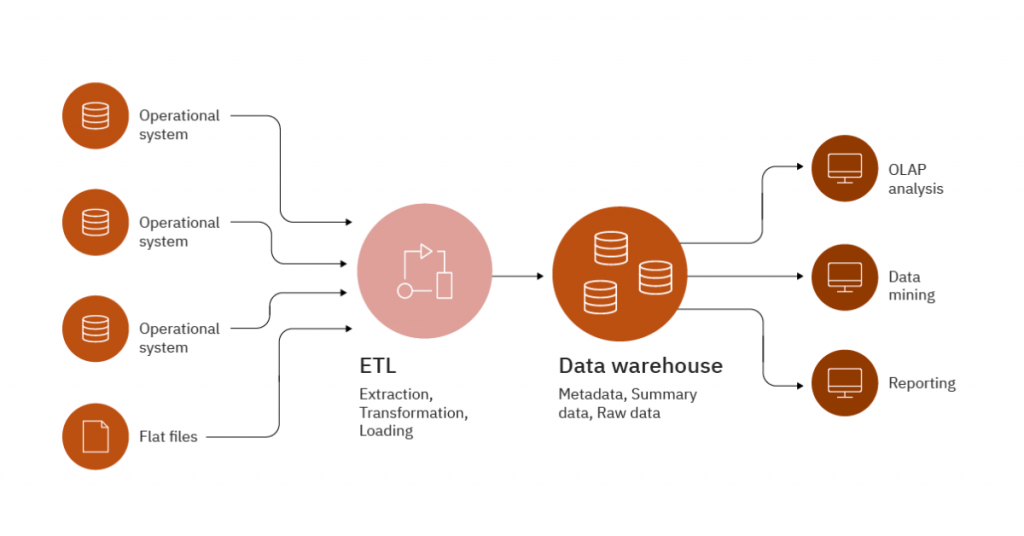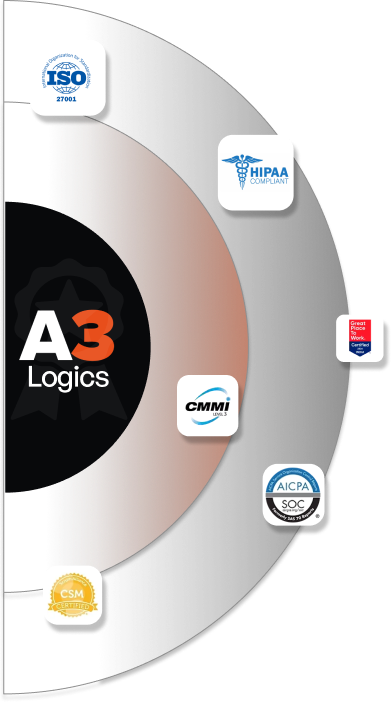Types of Data Warehouse: Every business nowadays relies substantially on information, typically obtained through transactions, client engagement, and website events that generate useful data. However, such data cannot be used right once to acquire insights into user trends and habits. This is where a data warehouse comes into play. They are often a centralized repository for storing, organizing, and analyzing massive amounts of historical data from various sources.

Various Types of Data Warehouse enable analysts to better exploit data to get insights and drive business progress.
Data warehousing plays a pivotal role in modern data management by consolidating data from various sources into one unified system. By doing so, it allows businesses to:
- Enhance decision-making through accurate and timely data.
- Improve operational efficiency by streamlining reporting and analytics.
- Support business intelligence (BI) applications and data mining for advanced analysis.
Whether you are a large enterprise or a growing startup, the right types of data warehouse can transform the way your business handles data. According to statistics the global data warehouse market comprises more than 37,000 companies.
Table of Contents
What is a Data Warehouse?
What are data warehouse? Well, data warehouses act as a central repository for storing and analyzing information in order to make more informed judgments. A data warehouse accepts data from a variety of sources, often on a regular basis, such as transactional systems, relational databases, and others.

A data warehouse is a centralized storage system that stores, analyzes, and interprets data to help make better decisions. Data warehouses are regularly populated with data from transactional systems, relational databases, and other sources.
A data warehouse is a sort of data management system that enables and supports business intelligence (BI) activities, particularly analysis.
Types of data warehouse are primarily intended to assist searches and analysis, and they typically include enormous amounts of historical data. A data warehouse is a collection of organizational data and information gathered from both operational and external data sources. By 2028, an estimated $7.69 billion is the growth projected for the data warehouse market.
Data is gathered on a regular basis from a variety of internal applications such as sales, marketing, and finance; customer-interface apps; and external partner systems. This information is then made available for decision-makers to review and analyze.
Key Characteristics of a Data Warehouse
Understanding the defining features of data warehouse types is essential to appreciate how it differs from other types of databases. The key characteristics of a data warehouse include:
> Subject-Oriented
Data warehouses are designed around key business subjects such as customers, products, sales, and inventory. This organization helps analysts focus on the most critical data for decision-making rather than dealing with transactional data that often lacks context.
> Integrated
Data in a data warehouse is integrated from different sources, which may include operational databases, external data providers, and even third-party systems. The integration process ensures consistency and accuracy across the data sets.
> Non-Volatile
Once data is entered into a data warehouse, it remains unchanged. This ensures that the data used for reporting and analytics is consistent and reliable, unlike transactional systems where data is frequently updated.
> Time-Variant
A data warehouse contains historical data that allows businesses to analyze trends over time. This is essential for forecasting and understanding long-term business patterns, unlike transactional systems, which store only current data.
Different Types of Data Warehouses
Data warehouses are intended to store and manage massive amounts of data from a variety of sources, allowing organizations to analyze and gain insights for decision making. Types of data warehouse are classified into numerous types based on their architecture, usage, and deployment style.

Here are some common types of data warehouse:
1. Enterprise Data Warehouse (EDW)
An Enterprise Data Warehouse (EDW) is an enterprise-level data warehouse type that is used by the entire organization. It combines data from various departments and offers a single version of truth for making decisions. EDWs are scalable, can manage large amounts of data, and are ideal for large enterprises.
2. Data Mart
A Data Mart is a smaller part of a data warehouse dedicated to a particular business unit or function, e.g., marketing, finance, or sales. It is best suited for small organizations or departments of large companies that require access to certain types of data for reporting and analysis.
3. Virtual Data Warehouse
In contrast to conventional data warehouse types, a Virtual Data Warehouse (VDW) does not store data physically. Instead, it integrates data from different systems in real-time via views and data virtualization tools. This type of warehouse is ideal for those organizations that need instant access to data from various sources without having to go through complicated ETL processes.
4. Real-Time Data Warehouse
A Real-Time Data Warehouse is meant to capture high-velocity data from operational systems. Real-time data warehouses provide real-time updates to enable real-time analytics, as opposed to traditional data warehouses where data gets updated in batches. These types of data warehouse are perfectly suited for finance and e-commerce that use minute-to-minute data.
5. Operational Data Store (ODS)
An Operational Data Store (ODS) is a database designed for storing real-time transactional data. It is generally applied for operational reporting and has access to near-real-time data. Similar to a data warehouse, an ODS concentrates on operational data instead of historical examination.
6. Cloud-Based Data Warehouse
A Cloud-Based Data Warehouse utilizes cloud technology to hold and manage data. Cloud warehouses are highly scalable, cost-effective, and flexible. Cloud data warehouses such as Google BigQuery, Amazon Redshift, and Snowflake are widely used because they are easy to use and cloud-native.
7. Analytical Data Warehouse
An Analytical Data Warehouse is primarily built for business intelligence and analytical workloads. It can hold large quantities of historical data and can enable sophisticated analytics, such as machine learning and predictive analysis.
How Does a Data Warehouse Work?
Data warehousing combines data and information from different sources into a single, comprehensive database. Types of data warehouse, for example, could bring together customer information from an organization’s point-of-sale systems, mailing lists, website, and comment cards. It may also contain confidential information regarding employees, such as salary details. Businesses employ data warehouse components to assess their customers.
Data mining is a function and feature of data warehouse that entails searching for relevant data patterns in massive amounts of data and developing novel tactics to enhance sales and profitability.
> ETL Process (Extract, Transform, Load)
The ETL process is central to how a data warehouse operates. Data is first extracted from various source systems, then transformed into a consistent format, and finally loaded into the data warehouse. This process ensures that the data is clean, accurate, and ready for analysis.
> Data Storage and Query Mechanism
Once data is loaded into the warehouse, it is typically organized into structured tables that support high-performance querying. Analytical queries, such as those used for reporting or forecasting, are run on this data to generate insights. Various Data warehouse types use optimized storage mechanisms and indexing strategies to handle complex queries efficiently.
What is Data Warehouse Automation?
Data Warehouse Automation (DWA) is the use of software tools and platforms to automate the design, development, deployment, and management of data warehouse types and associated operations. DWA optimizes the whole data pipeline, from data ingestion to analytics, by automating repetitive operations, eliminating manual involvement, and increasing overall efficiency.
Impact on Data Engineering Processes
Data warehouse automation significantly speeds up the development of types of data warehouse and reduces the chances of human error. It also simplifies data pipeline creation and maintenance, making it easier for data engineers to focus on higher-level tasks like optimizing query performance or ensuring data governance.
Key Features of Data Warehouse Automation Tools
Data warehouse automation tools come with a variety of features designed to streamline data engineering services. Some of the key features of data warehouse automation include:
1. Code Generation
DWA tools provide optimal code for ETL procedures, data transformations, and SQL queries, which saves time and ensures best practices.
2. Meta Data Management
Automated metadata management tracks data lineage, dependencies, and transformations, ensuring visibility and traceability throughout the data pipeline.
3. Version Control
DWA platforms include version control tools for managing changes, revisions, and deployments, assuring consistency and governance in data warehouse development.
4. Data Quality and Governance
Automated data profiling, validation, and cleansing functions increase data quality and ensure compliance with data governance policies and standards.
5. Integration with BI and Analytics
DWA products interface easily with business intelligence (BI) and analytics platforms, allowing users to efficiently access, analyze, and visualize data insights.
How to Choose the Right Type of Data Warehouse?
Choosing the proper types of data warehouse is determined by several criteria, including your company’s needs, size, and budget. A small business may want to use a cloud-based data warehouse since it is a more cost-effective way to store and analyze data without investing in physical hardware.
A medium-sized company may utilize a data mart to examine data at a more granular level, whilst a large organization may employ an enterprise data warehouse to analyze enormous amounts of data from many sources and provide a comprehensive view of all their data.
The cost of a data warehouse varies substantially based on the types of data warehouse, the size of the company, and the amount of data to be stored.
A corporate data warehouse might cost millions of dollars to set up and operate, but a cloud-based data warehouse may cost a few thousand dollars each month.
A medium-sized corporation could expect to pay up to $500,000 per year for a data warehouse solution.
Cloud vs. On-Premise
Cloud-based data warehouses offer flexibility and scalability, while on-premise solutions provide more control and security. The choice depends on factors like budget, security needs, and IT infrastructure.
Real-Time Needs
For businesses that need up-to-the-minute data for decision-making, real-time data warehouse types are the best option. However, if historical analysis is more important, a traditional EDW or data mart might suffice.
Data Warehouse Example
A data warehouse in healthcare is a centralized repository that collects and saves data from a variety of systems, including Electronic Health Records (EHR), billing systems, lab information systems, radiology platforms, hospital administration systems, and customer relationship management (CRMs). These data sources are generally siloed, making it difficult for healthcare practitioners to make timely and efficient decisions.
To address this, the hospital uses an ETL (Extract, Transform, and Load) method. Data is retrieved from all departments, converted to standardized formats (such as ICD-10 codes, date formats, and patient IDs), and fed into a cloud-based data warehouse platform like AWS Redshift or Azure Synapse Analytics. This procedure guarantees that data is consistent, accurate, and available in real time or at regular intervals.
Types of data warehouse architecture uses a star schema, with the fact table containing core data such as patient visits and the dimension tables including patient demographics, departments, services, and payment methods. This framework allows for rapid querying and extensive data analysis across multiple departments.
Once deployed, the warehouse can accommodate a wide range of use cases. Doctors get fast access to patient histories, test data, and medication records via a single dashboard. Administrators enhance hospital operations by examining admission, discharge, and staffing patterns. Finance departments employ real-time information to manage insurance claims, revenue cycles, and payment reconciliation.
The hospital can also use AI-powered predictive analytics to anticipate readmission rates, track patient outcomes, and assist population health efforts. Regulatory compliance is simplified with quick report production for HIPAA, Medicare, and insurance audits, saving time and resources.
A healthcare data warehouse not only centralizes data but also enables healthcare organizations to improve patient care, cut operational costs, and make data-driven choices across all departments.
Data Warehousing Tools
Wondering what are data warehouse tools? These are software components that conduct multiple operations on a large dataset. These tools facilitate the collection, reading, writing, and transmission of data from a variety of sources. What do data warehouses support? They are intended to facilitate activities such as data sorting, filtering, and merging.
- Google BigQuery: A serverless, highly scalable data warehouse.
- Amazon Redshift: A fast, scalable data warehouse in the cloud.
- Snowflake: A cloud-native data platform with data warehousing and analytics capabilities.
- Microsoft Azure Synapse Analytics: An integrated analytics platform for big data and data warehousing.
Comparison Based on Features, Pricing, and Scalability
While each tool has its strengths, factors such as budget, scalability, and the ability to integrate with other tools should guide your choice.
| Tool | Key Features | Pricing Model | Scalability | Integration Support |
| Google BigQuery | Serverless, real-time analytics, built-in ML | Pay-as-you-go | Auto-scaling, handles petabyte-scale data | Google Cloud ecosystem |
| Amazon Redshift | Columnar storage, high performance, Redshift Spectrum | On-demand or reserved instance | High scalability with concurrency scaling | AWS services |
| Snowflake | Multi-cluster compute, cross-cloud support, secure data sharing | Per-second usage pricing | Independent scaling of storage & compute | Works across AWS, Azure, GCP |
| Azure Synapse Analytics | Unified data integration, T-SQL support, Spark integration | Pay-per-use or provisioned models | Scalable for big data and enterprise use | Deep integration with Microsoft ecosystem |
Benefits of a Data Warehouse
Data warehouses provide various advantages to firms, allowing them to properly organize and use their data for decision-making and strategic planning. Here are some major advantages of types of data warehouse:
1. Centralized Repository
Data warehouses provide a centralized repository for storing data from multiple sources throughout the enterprise. This centralized method assures data consistency, integrity, and a single point of reference for reporting and analysis.
2. Data Integration
Data warehouses combine data from several sources, including operating systems, databases, spreadsheets, and external sources. This integration enables firms to combine and evaluate data from many sources in order to acquire a complete picture of their company operations.
3. Historical Data Analysis
Data warehouses hold historical data over time, allowing organizations to undertake trend analysis, find patterns, and monitor changes in business KPIs and performance over time. This historical viewpoint is critical for making sound decisions and developing future plans.
4. Improved Data Quality
Data warehouses frequently use data cleansing, transformation, and validation processes to assure data quality and accuracy. Data warehouses improve data reliability and trustworthiness by standardizing data formats, resolving errors, and eliminating duplication.
5. Business Intelligence and Analytics
Data warehouses enable business intelligence (BI) and analytics capabilities by offering an organized and efficient environment for querying, reporting, and data visualization. Users may develop relevant insights, construct dashboards, and execute ad hoc analysis to make data-driven decisions and track key performance indicators (KPIs).
6. Scalability and Performance
Modern data warehouse types, particularly those built on cloud platforms, can handle massive amounts of data and meet expanding business demands. They are intended to provide excellent performance for complex queries, data processing, and analytics jobs, ensuring rapid access to information for decision-makers.
7. Data Security and Governance
Data warehouses utilize security measures and access controls to secure sensitive information and maintain regulatory compliance. They help firms adopt data governance standards, monitor data access and usage, and track data changes for audit and compliance purposes.
8. Cost efficiency
While building and maintaining a data warehouse takes an initial investment, it can result in long-term cost savings by optimizing data management procedures, decreasing data silos, minimizing duplicate efforts, and boosting operational efficiency through data-driven decision making.
Why Choose A3Logics?
When choosing a data warehousing solution, it’s essential to partner with a trusted provider that can deliver customized services tailored to your business needs. A3Logics offers expert data engineering services and data analytics solutions designed to help organizations build, manage, and optimize their data warehouses.
Overview of A3Logics Expertise in Data Warehousing Solutions and Data Analytics Services
A3Logics brings years of experience in the data engineering field, assisting organizations with building scalable and efficient types of data warehouse architecture. Whether you need to migrate your data to a cloud-based data warehouse or develop custom ETL processes, A3Logics can provide end-to-end support.
Their team of skilled professionals can help you:
- Design and implement enterprise data warehouses (EDWs) and data marts that fit your business structure.
- Automate ETL processes using cutting-edge tools and technologies.
- Integrate data from disparate sources to create a unified data repository.
- Optimize data warehousing performance for enhanced analytics and reporting.
Unique Value Propositions
- Tailored Solutions: A3Logics provides solutions that are customized to your specific business needs, ensuring that you get the most out of your data warehouse.
- Cloud Expertise: Whether you are considering a cloud-based solution like Google BigQuery or AWS Redshift, A3Logics has the expertise to help you deploy scalable, secure, and cost-effective cloud data warehouses.
- Comprehensive Support: A3Logics offers ongoing support for data governance, performance optimization, and data quality assurance, ensuring that your data warehouse continues to deliver reliable insights.
Conclusion
Choosing the right type of data warehouse is a critical decision for businesses that rely on data-driven insights for growth. Understanding the various types of data warehouses—including Enterprise Data Warehouse (EDW), Data Mart, Cloud-Based Data Warehouse, Data Lifecycle Management and more—can help organizations make informed choices that align with their specific needs.
Key factors such as data volume, real-time requirements, scalability, and integration capabilities should guide your decision-making process. By implementing the right type of data warehouse, organizations can unlock new opportunities for advanced analytics, operational efficiency, and strategic decision-making.
For businesses looking to optimize their data management and analytics capabilities, partnering with experienced professionals like A3Logics can streamline the process and provide you with the right tools for success.
In summary, whether you’re scaling up, integrating real-time data, or looking for an enterprise-level solution, the right types of data warehouse will support your business’s growth and enable better decision-making.






